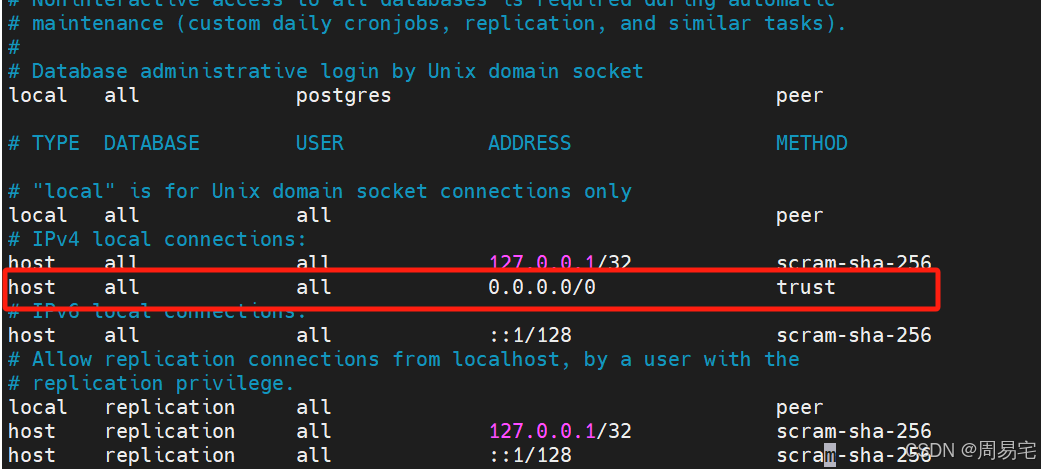算法原理
A*算法通过以下公式计算节点的优先级:
f(n)=g(n)+h(n)
- f(n):节点 n的总优先级,表示从起点通过节点 n 到目标点的估计代价。
- g(n):从起点到节点 n 的实际代价。
- h(n):从节点 n到目标点的启发式估计代价。
A*的核心是选择具有最低 f(n)值的节点进行扩展,从而在保证正确性的同时提高效率。
启发函数(Heuristic Function)
启发函数 h(n)决定了算法的效率和准确性:
-
一致性(Consistency):如果 h(n)满足三角不等式,即 h(n)≤c(n,n′)+h(n′),算法可以保证最优性。
-
常用启发函数:
- 曼哈顿距离(适用于网格地图):
h(n)=∣x1−x2∣+∣y1−y2∣- 欧几里得距离(适用于几何地图):

- 自定义启发函数:针对特定场景设计的函数。
算法流程
初始化:
- 将起点加入开放列表(Open List)。
- 关闭列表(Closed List)为空。
迭代搜索:
- 从开放列表中选择 f(n)最小的节点 n。
- 如果 n 是目标节点,终止并返回路径。
- 将 n 从开放列表移除,并加入关闭列表。
- 扩展节点 n 的所有邻居节点:
- 如果邻居不在关闭列表中:
- 计算邻居的 g(n)、h(n)和 f(n)。
- 如果邻居不在开放列表中,将其加入开放列表。
- 如果邻居已在开放列表中且新的 g(n) 更优,更新邻居的值。
- 如果邻居不在关闭列表中:
返回结果:
- 如果开放列表为空,表示无解。
- 否则返回路径。
代码实现
#include <iostream>
#include <vector>
#include <queue>
#include <cmath>
#include <unordered_map>
using namespace std;
// 定义网格节点
struct Node {
int x, y; // 坐标
double g, h, f; // 代价
Node* parent; // 父节点
Node(int x, int y, double g = 0, double h = 0, Node* parent = nullptr)
: x(x), y(y), g(g), h(h), f(g + h), parent(parent) {}
bool operator>(const Node& other) const {
return f > other.f; // 优先队列按 f 值排序
}
};
// 启发函数:曼哈顿距离
double heuristic(int x1, int y1, int x2, int y2) {
return abs(x1 - x2) + abs(y1 - y2);
}
// 检查点是否在网格内
bool isValid(int x, int y, int rows, int cols) {
return x >= 0 && x < rows && y >= 0 && y < cols;
}
// A* 搜索
vector<pair<int, int>> aStarSearch(vector<vector<int>>& grid, pair<int, int> start, pair<int, int> goal) {
int rows = grid.size();
int cols = grid[0].size();
priority_queue<Node, vector<Node>, greater<Node>> openList; // 最小堆
unordered_map<int, bool> closedList; // 关闭列表(标记访问的点)
auto encode = [&](int x, int y) { return x * cols + y; }; // 坐标哈希
// 初始节点
Node* startNode = new Node(start.first, start.second, 0, heuristic(start.first, start.second, goal.first, goal.second));
openList.push(*startNode);
// 定义方向向量
vector<pair<int, int>> directions = {{-1, 0}, {1, 0}, {0, -1}, {0, 1}};
while (!openList.empty()) {
Node current = openList.top();
openList.pop();
// 检查是否到达目标
if (current.x == goal.first && current.y == goal.second) {
vector<pair<int, int>> path;
Node* temp = ¤t;
while (temp) {
path.emplace_back(temp->x, temp->y);
temp = temp->parent;
}
reverse(path.begin(), path.end());
return path;
}
// 标记当前点为访问过
closedList[encode(current.x, current.y)] = true;
// 扩展邻居节点
for (auto& dir : directions) {
int nx = current.x + dir.first;
int ny = current.y + dir.second;
if (isValid(nx, ny, rows, cols) && grid[nx][ny] == 0 && !closedList[encode(nx, ny)]) {
double g = current.g + 1; // 假设代价为1
double h = heuristic(nx, ny, goal.first, goal.second);
openList.push(Node(nx, ny, g, h, new Node(current.x, current.y, current.g, current.h, current.parent)));
}
}
}
return {}; // 无解
}
int main() {
vector<vector<int>> grid = {
{0, 0, 0, 0, 0},
{0, 1, 1, 1, 0},
{0, 0, 0, 1, 0},
{0, 1, 0, 0, 0},
{0, 0, 0, 0, 0},
};
pair<int, int> start = {0, 0};
pair<int, int> goal = {4, 4};
vector<pair<int, int>> path = aStarSearch(grid, start, goal);
if (!path.empty()) {
cout << "Path found:\n";
for (auto& p : path) {
cout << "(" << p.first << ", " << p.second << ") -> ";
}
cout << "Goal\n";
} else {
cout << "No path found.\n";
}
return 0;
}
时间复杂度
- 最坏情况:O(E),其中 E 是图的边数。
- 在稀疏图中效率较高,常结合优化数据结构(如 Fibonacci 堆)提升性能。
应用场景
- 地图导航(如 Google Maps)。
- 游戏 AI 路径规划。
- 机器人路径规划。



















